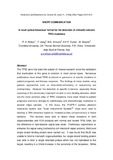- CERES Home
- →
- Cranfield Health
- →
- Staff publications - Cranfield Health
- →
- View Item
JavaScript is disabled for your browser. Some features of this site may not work without it.
| dc.contributor.author | Wilson, P. K. | |
| dc.contributor.author | Jiang, T. | |
| dc.contributor.author | Minunni, Maria E. | |
| dc.contributor.author | Turner, Anthony P. F. | |
| dc.contributor.author | Mascini, Marco | |
| dc.date.accessioned | 2009-04-24T18:27:40Z | |
| dc.date.available | 2009-04-24T18:27:40Z | |
| dc.date.issued | 2005-05-15 | |
| dc.identifier.citation | P.K. Wilson, T. Jiang, M.E. Minunni, A.P.F. Turner, M. Mascini, A novel optical biosensor format for the detection of clinically relevant TP53 mutations, Biosensors and Bioelectronics, Volume 20, Issue 11, 15 May 2005, Pages 2310-2313 | en_UK |
| dc.identifier.issn | 0956-5663 | |
| dc.identifier.uri | http://dx.doi.org/10.1016/j.bios.2004.11.020 | |
| dc.identifier.uri | http://hdl.handle.net/1826/3350 | |
| dc.description.abstract | The TP53 gene has been the subject of intense research since the realisation that inactivation of this gene is common to most cancer types. Numerous publications have linked TP53 mutations in general or at specific locations to patient prognosis and therapy response. The findings of many studies using general approaches such as immunohistochemistry or sequencing are contradictory. However, the detection of specific mutations, especially those occurring in the structurally important L2 and L3 zinc binding domains, which are the most common sites of TP53 mutations, have been linked to patient prognosis and more strongly to radiotherapy and chemotherapy resistance in several major cancers. In this study, the TI-SPR-1 surface plasmon resonance system and Texas Instruments Spreeta™ chips were used to develop a DNA biosensor based on thiolated probes complementary to these domains. The sensors were able to detect these mutations in both oligonucleotides and PCR products with normal and mutant TP53 DNA, but the difference in hybridisation signal was small. Preliminary experiments to enhance the signal using Escherichia coli mismatch repair proteins, MutS and single strand binding protein were carried out. It was found that MutS was unable to bind to mismatch oligonucleotides, but single strand binding protein was able to bind to single stranded probes, which had not hybridised to the target, resulting in a three-fold increase in the sensitivity of the biosensor. While further work needs to be carried out to optimise the system, these preliminary experiments indicate that the TI-SPR-1 can be used for the detection of clinically relevant mutations in the TP53 gene and that the sensitivity can be increased significantly using single strand binding protein. This system has a number of advantages over current mutation detection technologies, including lower cost, ease of sensor preparation and measurement procedures, technical simplicity and increased speed due to the lack of need for gel electrophoresis. | en_UK |
| dc.language.iso | en | en_UK |
| dc.publisher | Elsevier | en_UK |
| dc.subject | TP53 mutation | en_UK |
| dc.subject | p53 Mutation | en_UK |
| dc.subject | DNA biosensor | en_UK |
| dc.subject | Surface plasmon resonance | en_UK |
| dc.subject | Mutation detection | en_UK |
| dc.subject | Optical biosensor | en_UK |
| dc.title | A novel optical biosensor format for the detection of clinically relevant TP53 mutations | en_UK |
| dc.type | Postprint | en_UK |
